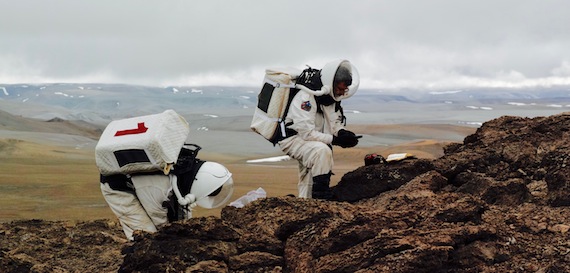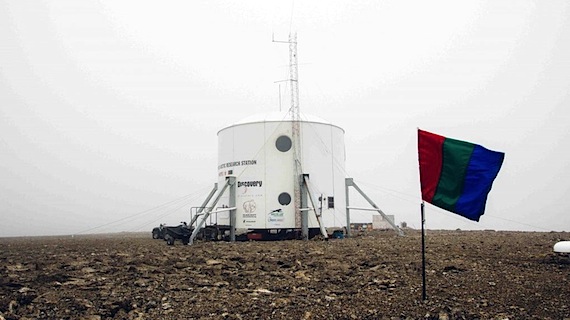Mars crew sets up shop again on Nunavut’s Devon Island
You don’t have to travel through the solar system to get to Mars.
That’s because you can find a bit of the Red Planet on Devon Island in Nunavut’s High Arctic, about 200 kilometers south of Grise Fiord on Ellesmere Island.
Many consider Devon’s Haughton Crater, a 20-kilometer-wide hole punched out by a meteor collision 23 million years ago, and its surrounding red rock formations — seemingly plucked from a Star Wars film — to be similar to what you’d find on a warmer Mars.

So much so, there are many who believe NASA’s Rover shots from Mars are instead shot on Devon Island — and they have produced many YouTube videos documenting the alleged hoax, prompting many semi-serious news stories with headlines like “The Wild Conspiracy Theory That NASA Is Faking Its Mars Rover Missions In Canada.” On these, you can see photos of rocks from a NASA Mars Rover shots, which some say show a walrus bone or a lemming.
Right now, an international “crew” of six has started a stay (three weeks late due to fog in Resolute Bay) at the edge of the Haughton Crater in a “hab” (short for habitat,) which looks like a large tin can, as part of a four-month “Mars 160 Mission” promoted by the Mars Society, which wants to see the colonization of Mars.
The white fiberglass habitat, called the Flashline Mars Arctic Research Station, was erected in July 21, 2000, around the same time as the 32nd anniversary of the first moon walk, and when this Nunatsiaq News reporter also managed to hop off a flight heading from Eureka to Resolute Bay to visit the site for a few days.
There, we learned that the loss of habitat’s key components in an airlift mishap, which included the crane that was to pull up the walls as well as the floors that were to hold these together, had caused problems for the Mars Society, its president and founder, Robert Zubrin, and his construction team:
They were under pressure to get the habitat up because Zubrin had pre-sold the rights to film the construction to the Discovery Channel for US $200,000.

Zubrin, the author of “The Case for Mars: The Plan to Settle the Red Planet and Why We Must,” has made the case that manned expeditions to Mars are possible and desirable. His message is that mankind thrives on adversity and that the exploration of Mars will start a new, positive era of human development.
Some of his Mars Society’s members want Mars to become a Utopian environment, with a new and better society where there’s no government intervention, while others want to develop new commercial opportunities, such as the sale of viewing rights to Mars, raising rabbits on Mars (“One giant leap”, say its proponents) or even burying the deceased on Mars.
For the past eight years, the Flashline station has been uninhabited. In 2005, major problems encountered by the station dwellers included the weather (bad,) mud (sticky,) spaghetti (too much) and the lack of email.
Then, after 2009, due to conflicts between Zubrin and scientists in the neighbouring Haughton-Mars “Mars on Earth” Project, who have, on and off since 1997, actually tested out some space-age tools at the same site, no one has returned to the station.
Since 2013, the Mars Society has been fundraising to revive the station, which it says will serve as a testing ground for Mars exploration, become a useful field research facility and generate public support for sending people to Mars.
According to logs on the Mars Society website, the crew (whose biographies you can read here) have undertaken “a scouting mission to the south to test trafficability to the Gemini Hills” in an EVA or Extra-Vehicular Activity, with protective suits and oxygen tanks, because when you’re pretending you’re an astronaut on Mars, rather than in Nunavut’s backyard, you can’t breathe the air.
A member of the crew also made a dish of rice with a number of different sauces containing lentils, beans, tomatoes, chocolate, coffee, maple syrup, honey, coconut milk, milk powder, soy sauce, raisins and many different spices: “These are just a few of the ingredients. We are hoping for better weather tomorrow, but the forecast is not good. We have plans for all contingencies.”
Their Flashline project does not appear on the list of High Arctic research groups supported by the Polar Continental Shelf Program, which provides logistical support to scientific projects, but its project description, sent to the Nunavut Research Institute, shows those in the station plan to look at lichens and various aspects of the geology of the crater during their stay.